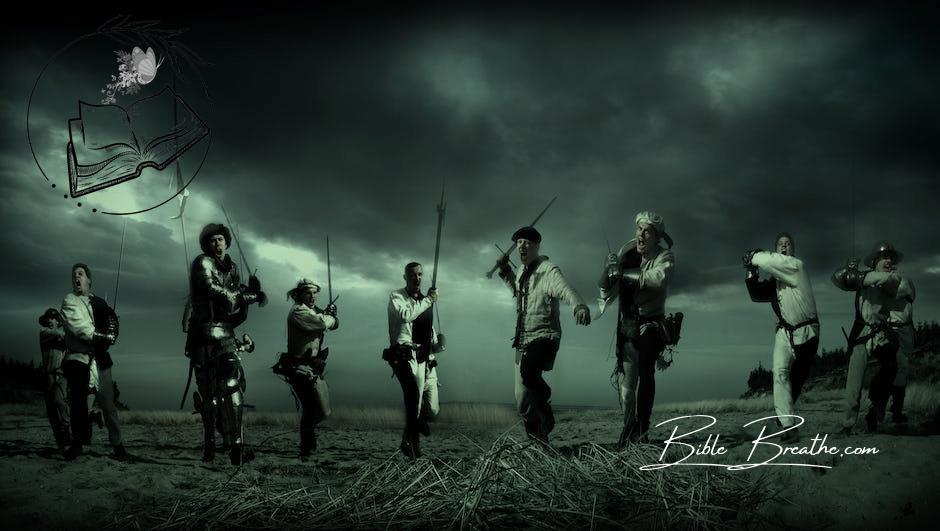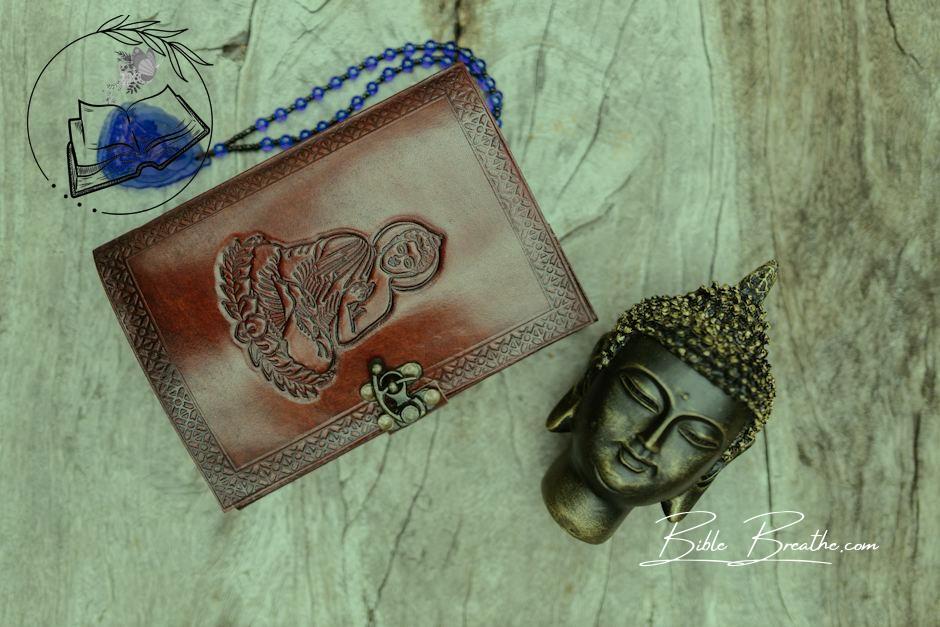Who hung on the crosses beside Jesus?
Picture it, fam, Golgotha—the ground trembling, the sky weeping.
At that divine intersection of heaven and earth, two souls shared the stage with our Savior.
First, the Good Thief, a dude named Saint Dismas, had a change of heart in his final moments.
He flipped the script and reached for salvation.
Then, there’s the Unrepentant Thief, the wild one called Gestas, who stuck to his guns.
Their stories in the crucifixion drama teach us about redemption and choices, even when facing a Roman-style beatdown.
Calvary’s where it all went down, fam.
So, we’re diving into the nitty-gritty of these two characters, seeing how their choices still resonate with us today.
Let’s break it down and learn from the past.
🙏🏽✝️
Key Takeaways
- The contrasting fates of the two thieves crucified alongside Jesus illustrate the choices individuals make in response to Jesus and the eternal consequences of those choices.
- One thief, mocking Jesus, represents a hardened heart and a rejection of salvation, ultimately facing spiritual condemnation. The other thief, recognizing Jesus’ innocence and lordship, demonstrates humility, repentance, and faith, resulting in Jesus promising him eternal paradise.
- This biblical account emphasizes the power of repentance and faith, highlighting that it’s never too late to turn to God and receive His grace and forgiveness. The thief’s repentance, even in his final moments, showcases the boundless mercy of God.
- Christians can derive valuable lessons from this story, understanding the significance of genuine repentance and the life-transforming power of faith in Jesus. It reinforces the belief that salvation is a gift available to all, regardless of their past, if they genuinely turn to God with a humble and contrite heart.
- The narrative emphasizes the importance of acknowledging Jesus as Lord and Savior, underlining that a heartfelt confession of faith, even in the direst circumstances, leads to redemption and an eternal relationship with God.
The Neighbors of Agony: Unveiling Those Crucified Alongside Jesus
Photo modified by BibleBreathe.com. Original photo by Anna Shvets on Pexels
When Jesus faced the excruciating cross, he wasn’t alone in that painful journey.
Standing on each side were two distinct figures: Dismas and Gestas, each with their own life tales etched into that significant day.
Dismas: A Heart Set on Repentance
Picture Dismas, often known as the “Good Thief,” holding a unique stance in that somber tableau.
While enduring the same agony as Jesus, there was a profound difference in his reaction.
Imagine someone whose life had taken a tumultuous path, entangled in a web of crimes and wrongdoings.
Yet, in those harrowing moments on the cross, he found a glimmer of redemption.
It’s like witnessing a phoenix rise from the ashes of his past.
Dismas seized the opportunity for salvation, uttering words that echoed hope:
“And he said unto Jesus, Lord, remember me when thou comest into thy kingdom.” – Luke 23:42 (KJV)
Gestas: The Heart That Wouldn’t Yield
On the opposite side stood Gestas, the epitome of unrepentance.
A stark contrast to Dismas, Gestas continued to spew bitterness and scorn, even in the face of excruciating pain.
It’s like witnessing a heart that remains hard, rejecting the gentle touch of grace.
In his unyielding pride, he missed the chance for redemption that was so palpably present.
This duality, showcased through Dismas and Gestas, reminds us that even in the bleakest of moments, the human spirit has a choice.
We can either embrace the prospect of transformation or reject it, ultimately shaping our destiny.
Legacy and Identity: Saint Dismas and Gestas
Photo modified by BibleBreathe.com. Original photo by Erik Karits on Pexels
The story of Dismas and Gestas doesn’t fade with the crucifixion.
Over centuries, tradition and faith have granted them distinct names and roles in the biblical drama.
Dismas, the “Good Thief,” transformed into Saint Dismas—a symbol of hope, forgiveness, and the power of repentance.
Conversely, Gestas, the unrepentant, became a cautionary tale, a reminder of the consequences of a stubborn heart.
In this crucible of agony and choice, history presented two contrasting figures—Dismas and Gestas—illustrating that, even in our darkest hours, we hold the power to choose our response, determining our place in the grand tapestry of existence.
The Surprising Tale of the Good Thief
Photo modified by BibleBreathe.com. Original photo by Anna Shvets on Pexels
When we gaze upon the crucifixion scene, a burning question stirs in the hearts of many: who was crucified next to Jesus? This inquiry unlocks a tale that echoes through time, painting a profound picture.
Unexpected Connections: Jesus and Dismas
In the midst of excruciating pain, an unforeseen bond formed.
To the right of Jesus hung Dismas, a convicted wrongdoer often dubbed the “Good Thief.” Dismas, somewhat overshadowed in this pivotal moment, carried the burden of his deeds.
Yet, in the midst of that agonizing crucible, a flicker of redemption ignited between him and Christ.
“And Jesus said unto him, Verily I say unto thee, Today shalt thou be with me in paradise.” – Luke 23:43 (KJV)
In those words, Jesus lit a spark of hope for Dismas, presenting an opportunity for salvation even in the face of impending death.
It’s a poignant reminder that grace and forgiveness transcend the boundaries of time and circumstance.
Dismas Redeemed: Lessons and Contemplations
Dismas, once labeled the “Unrepentant Thief” but transformed into the “Good Thief,” embodies the potential for change and redemption, even amid our darkest hours.
His narrative stands as a timeless illustration that no one is beyond the reach of forgiveness and redemption.
As we ponder this event, we’re challenged to assess our own lives.
Are we willing to seek forgiveness and redemption, even in our bleakest hours?
Can we summon the courage to alter our course, no matter how dire our circumstances may appear?
The crucifixion tableau, with Jesus and the two thieves, encapsulates the very core of mercy, compassion, and the limitless love of God.
It stands as a beacon of hope, proclaiming that even amidst the most dismal circumstances, salvation is attainable for those who seek it.
Let’s reflect on this event and draw inspiration from Dismas’ journey – a journey from condemnation to salvation, from darkness to light.
Dismas’ tale serves as a reminder that it’s never too late to veer toward righteousness and find grace, even in the eleventh hour.
The Crossroads of Fate: Gestas, the Unrepentant Neighbor on Calvary’s Hill
Photo modified by BibleBreathe.com. Original photo by Anna Shvets on Pexels
In the chilling backdrop of Jesus’ crucifixion, a striking contrast unfolds between two souls crucified beside him—Dismas, the heart seeking redemption, and Gestas, the unyielding spirit.
Their stories unveil profound lessons for us all.
Dismas: A Glimmer of Redemption
Dismas, dubbed the “Good Thief,” emerges as a beacon of hope amidst the agony.
Imagine a life marked by wrongdoings and stumbles, yet facing death, a glimmer of regret sparks a profound change.
Dismas seized the chance for salvation, voicing a plea that echoes through the annals of time.
“And he said unto Jesus, Lord, remember me when thou comest into thy kingdom.” – Luke 23:42 (KJV)
Gestas: The Thorny Path of Stubbornness
In stark contrast to Dismas, Gestas clung to pride and bitterness, even amid the excruciating crucible.
His heart, hardened and unrepentant, painted a tragic portrait of a soul consumed by ego, unable to see beyond his own pain.
At that critical crossroads, he turned away from redemption, sealing his fate.
Gestas’ story stands as a poignant reminder that, even in the presence of the divine, the human will can remain steadfastly unmoved.
It serves as a cautionary tale, urging us to reflect on the perils of a heart unwilling to soften, a spirit resistant to change.
Lessons from the Crucible
Photo modified by BibleBreathe.com. Original photo by Rene Asmussen on Pexels
The sharp contrast of Dismas and Gestas exposes a fundamental truth—the power of choice in shaping our destiny.
Dismas’ choice, to acknowledge his wrongs and seek forgiveness, opened the door to grace and redemption.
Conversely, Gestas’ pride-fueled decision led to a tragic conclusion, denying him the possibility of salvation.
Their narratives compel us to contemplate: When faced with life-altering decisions, will we allow pride and bitterness to obscure our judgment, or will we embrace humility and transformation?
The tableau of the crucifixion serves as a reminder that redemption is within grasp, but we must be willing to shed our pride and open our hearts to the promise of grace.
The Crucifixion Puzzle: Who Stood by Jesus?
Photo modified by BibleBreathe.com. Original photo by RDNE Stock project on Pexels
In the harrowing tale of Jesus’ crucifixion, one aspect often slips through the cracks – the presence of others nailed to crosses beside him.
Who was crucified next to Jesus? To truly grasp the gravity of this question, we need to dive into the historical and biblical backdrop of Roman crucifixions and unravel the symbolic weight of having thieves crucified alongside the Son of Man.
Roman Crucifixion: A Brutal Display
In the grim era of Roman dominance, crucifixion stood as a ghastly and all-too-common form of execution.
It was a savage public exhibition of power, a stark warning to any who dared oppose.
Those condemned to this fate were thrust into immense suffering and humiliation, left to wither away slowly and painfully on the cross.
Crucifixions were staged in highly visible spots, like Calvary or Golgotha, to maximize their deterrent effect.
The aim extended beyond mere execution; it was a gruesome spectacle meant to terrify.
This brutal reality forms the backdrop against which Jesus and the two thieves faced their fateful hours.
Symbolic Placement of Thieves: A Profound Message
The strategic positioning of the two thieves, later immortalized as the “Good Thief” and the “Unrepentant Thief,” next to Jesus carries profound symbolism.
These criminals embodied the duality of human choice: one chose to scoff and deny salvation, while the other, amidst suffering, recognized Jesus’ divinity and sought redemption.
“And one of the malefactors which were hanged railed on him, saying, If thou be Christ, save thyself and us. But the other answering rebuked him, saying, Dost not thou fear God, seeing thou art in the same condemnation? And we indeed justly; for we receive the due reward of our deeds: but this man hath done nothing amiss.” – Luke 23:39-41 (KJV)
Their crucifixion alongside Jesus underscored the fundamental choice each person faces – the choice between embracing salvation, like the “Good Thief,” or rejecting it in pride and disbelief, like the “Unrepentant Thief.”
The excruciating scene of the crucifixion, with Jesus and the thieves, is a potent reminder that even in the darkest of circumstances, redemption remains within reach.
It’s an open invitation to all of humanity, regardless of their past actions, to turn towards grace, seek forgiveness, and embrace salvation.
The crucifixion of the thieves wasn’t just a historical event; it symbolized the eternal choice that echoes through generations.
Unexpected Grace-Bearer: Simon of Cyrene on Calvary’s Road
In the gut-wrenching saga of Jesus’ path to the cross, an unanticipated figure steps into the spotlight—Simon of Cyrene.
His role in that defining moment not only physically aided Jesus, weighed down by the cross, but it also held a symbolic message echoing through humanity.
Extending a Helping Hand in the Abyss of Agony
Imagine the tumultuous scene: a crowd teeming with mixed emotions, the heavy burden of a wooden cross pressing upon Jesus’ wounded back.
In this chaos, Simon of Cyrene emerges as an unsought helper, thrust into service to share the load.
His willingness to step up, to bear the weight that Jesus bore, reveals a glimpse of the compassion and solidarity that can exist even in the darkest of moments.
“And they compel one Simon a Cyrenian, who passed by, coming out of the country, the father of Alexander and Rufus, to bear his cross.” – Mark 15:21 (KJV)
The Profound Lesson in an Unexpected Act
Though seemingly coerced into his role, Simon’s act holds a deeper meaning.
It illuminates how at times, we’re called upon to carry burdens that weren’t originally ours, to support others in their trials.
In a world often consumed by self-interest, Simon’s act of shouldering Jesus’ cross stands as a reminder of the need for selfless assistance, even when unexpected and demanding.
Lessons in Surprising Acts of Kindness
The journey to Golgotha, with Simon’s reluctant yet vital assistance, urges us to contemplate our actions in a world weighed down by suffering.
Are we willing to step into the lives of others, to bear their burdens, and assist in their pain?
Simon’s story nudges us to be those helping hands, to share the weight of the cross others carry, and in doing so, bring moments of respite and hope.
The Tale of Two Crossmates: A Story of Choices
In the profound drama of Jesus’ crucifixion, the sight of two fellow souls on crosses beside him raises an intriguing question: who was crucified next to Jesus? Unveiling this inquiry unveils a story of two kindred fates and the symbolic battle between good and evil amidst the ultimate sacrifice.
A Twist of Fate: The Brotherhood Narrative
Traditionally, the two thieves crucified next to Jesus have been described as brothers in arms, their lives entangled in the shadows of criminality.
Yet, their paths sharply diverged in those critical moments on the hill of Golgotha.
Historically, they were both labeled as criminals deserving the brutal punishment they faced.
However, the depth of their souls and their response to Jesus’ presence on the cross present a striking dichotomy – a representation of choices and their consequences.
Symbolic Dichotomy: The Biblical Tale
The story of the “Good Thief” and the “Unrepentant Thief” mirrors a biblical parable.
The “Good Thief,” often revered as Saint Dismas, embodies the repentant sinner, the one who, even in the throes of death, found redemption by acknowledging Christ’s divinity.
“And he said unto Jesus, Lord, remember me when thou comest into thy kingdom. And Jesus said unto him, Verily I say unto thee, Today shalt thou be with me in paradise.” – Luke 23:42-43 (KJV)
Conversely, the “Unrepentant Thief” persisted in mockery, a life unrepentant and void of acknowledging the divine.
The stark contrast in their responses illustrates the fundamental human choice: to embrace salvation through humility and recognition of one’s faults, or to persist in defiance and face the consequences.
Their crucifixion alongside Jesus, the epitome of grace and mercy, adds an unparalleled layer of depth to the narrative.
It serves as a reminder that even in the darkest moments, the opportunity for salvation persists.
The two thieves, in their final earthly hours, provide an eternal lesson on choice, redemption, and the boundless grace of God.
Frequently Asked Questions (FAQs) About Who Was Crucified Next To Jesus
What happened to the two thieves crucified with Jesus?
The two thieves crucified with Jesus are mentioned in the Gospels.
One repented and asked for Jesus’ mercy, and Jesus promised him paradise.
The other remained unrepentant.
This event highlights the contrast between belief and unbelief in the face of Christ’s crucifixion.
What did Saint Dismas say to Jesus?
According to tradition, Saint Dismas, one of the two criminals crucified alongside Jesus, is said to have spoken to Jesus, asking Him to remember him when He comes into His kingdom.
Jesus responded by assuring Dismas that he would be with Him in paradise, indicating His mercy and forgiveness even in the midst of suffering (Luke 23:42-43).
Who was crucified not Jesus?
In the Bible, historical records don’t document someone being crucified in the context of Jesus’ redemptive crucifixion.
Crucifixion was a common execution method in that era, but the significance of Jesus’s crucifixion lies in His role as the Savior, sacrificing for humanity’s sins.
Who was with Mary when Jesus was crucified?
John, the disciple whom Jesus loved, was with Mary at the crucifixion.
Jesus entrusted Mary into John’s care, demonstrating the importance of community and support even in the midst of profound suffering.
{
“@context”: “https://schema.org”,
“@type”: “FAQPage”,
“mainEntity”: [
{
“@type”: “Question”,
“name”: “What happened to the two thieves crucified with Jesus?”,
“acceptedAnswer”: {
“@type”: “Answer”,
“text”: “The two thieves crucified with Jesus are mentioned in the Gospels. One repented and asked for Jesus’ mercy, and Jesus promised him paradise. The other remained unrepentant. This event highlights the contrast between belief and unbelief in the face of Christ’s crucifixion.”
}
},
{
“@type”: “Question”,
“name”: “What did Saint Dismas say to Jesus?”,
“acceptedAnswer”: {
“@type”: “Answer”,
“text”: “According to tradition, Saint Dismas, one of the two criminals crucified alongside Jesus, is said to have spoken to Jesus, asking Him to remember him when He comes into His kingdom. Jesus responded by assuring Dismas that he would be with Him in paradise, indicating His mercy and forgiveness even in the midst of suffering (Luke 23:42-43).”
}
},
{
“@type”: “Question”,
“name”: “Who was crucified not Jesus?”,
“acceptedAnswer”: {
“@type”: “Answer”,
“text”: “In the Bible, historical records don’t document someone being crucified in the context of Jesus’ redemptive crucifixion. Crucifixion was a common execution method in that era, but the significance of Jesus’s crucifixion lies in His role as the Savior, sacrificing for humanity’s sins.”
}
},
{
“@type”: “Question”,
“name”: “Who was with Mary when Jesus was crucified?”,
“acceptedAnswer”: {
“@type”: “Answer”,
“text”: “John, the disciple whom Jesus loved, was with Mary at the crucifixion. Jesus entrusted Mary into John’s care, demonstrating the importance of community and support even in the midst of profound suffering.”
}
}
]
}







